#ASALLUHI
Text

New Years Feast
In one phase of the Babylonian New Years Festival, the statue of Nabu would be brought into the city's temple and reunited with his parents, Marduk and Sarpanit.
Happy new year to you all! Hope 2023 brings good things.
46 notes
·
View notes
Text
Aiwass nigram geminam significat, Hoor-paar-Kraat, quae cum Set, Sirio "B" aequat, velata Amenta regna et "Universi B".
AKARIS (MU): Thread-Shaper. Associatus cum Ursa maiore.
AKRABU (SAB): Scorpius Man. Scorpius.
AL (HEB): Deus, Antiquissimus, Magnus Vetus.
AL AZIF (HPL): Arabice titulus originalis "Necronomicon".
ALMASS, THE (HPL): Haunters of Gobi Desert.
ANNA (SAB) : Aere.
ANNEDOTI (SM): De foeda vel detestanda. Veteribus in amphibio a Beroso Magno nomen datum.
ANNUNAKI (Nec): Septem Orci domini. Canis Face.
ANU (SAB): Sphaera Ain. Domine de caelis. Magnus Vigilius (cum Enlil et Enki).
AOSSIC (KG): Sicut Aiwass, alius medius inter homines et Magnos Veteres.
AR (NEC): Quinque acuta stella, notatio.
ARAK (MU): De Primogenito, Deorum Seniorum.
ARRA (Nec): Sigillum Foederis Deorum Seniorum.
ARZIR (NEC): Portam.
ARUKAI (MU): Umbra Dominus et Custos montium Rhyhl (R'lyeh).
ASALLUHI (SAB): Rex, Dominus magicae. Variatio Marduk.
ASATHOTH (MU): Perditor. Insigne, incantatio ignis. Sol duplicatus, qui aestus facit. See Azathoth.
ATLACH-NACHA (CAS): Araneus ingens deus. Describitur in "Septem Geases" quasi quaedam facies in corpore ebeno salaputium, depressum inter crura plurium articulata.
Aleister Crowley
0 notes
Text


“The wise Enki gathered around him his closest friends…”
“Enki, the lord of abundance and of rightful orders; Lord of the understanding, knowing one
of the land; Leader of the gods; Chosen for (his) knowledge, the lord of Eridu”
Enki in the world of The Flower from Tiamat's Fire
The Five rule the world with an iron fist, and Enki is no different. He is a water mage and the
wisest and most powerful of them all. Enki is famous for two things: his longevity and his
love for procreating. Enki has 128 sons (that we know of) and many daughters.
Centuries ago, it was him who alongside Enlil, Shamash, Ishtar and Ereshkigal put Tiamat to
sleep and have been ruling the world since then. When Ishtar decided to descend into
Irkalla, it was Enki who pleaded with Ereshkigal to release her sister and swore he would keep Ishtar away from the entrance, and later entrusted the protection of the gate to Irkalla to one of his many sons, the air mage and former general of Enki, Niall.
Enki in mythology
Enki is a very important deity in Sumerian mythology. He is the god of water, wisdom, creation, artisans and craftsmen, semen and fertility. He is the abundance giver. One of his
epithets, Nudimmud means “imagine fashioner” which relates to his role in creating humanity
as well as the importance of his water domain: because water makes clay plastic and can be
shaped.
Enki is one of the supreme gods in the Sumerian pantheon alongside Enlil and An. He is also the patron deity of Eridu; the oldest city in Sumer, according to Sumerian tradition. From
there his cult spread to other Sumerian city states. His temple in Eridu was called House of
Water.

Ruins of Eridu
His domain is Abzu: a freshwater ocean underground. Here it is said that Utu/Shamash (the
sun) goes to rest every night. It is the water of Abzu that was used to mix with clay. Abzu
was also the place bitumen allegedly came from.
The exact name meaning of Enki is uncertain. The two most common translations are “Lord
(of the) Earth” or “Lord Abundance”. His Akkadian counterpart is Ea.
The deity is also closely associated with canals, irrigation, boats, reeds and cleansing power
of incantation waters. He is also the holder of me-s: the divine norms of civilisation.
According to Sumerian tradition, it was Enki who made people speak different languages -
he divided it into many.

Enki, with two streams of water springing from his shoulders and his symbol, the goatfish sitting at his feet
Enki has had many consorts: Damkina, Ninhursag, Ninsar, Ninkura, Uttu (not to be confused
with Utu); and many children: Nanshe, Ninsar, Ninkura, Uttu, Ninkasi, Ninti, Asalluhi, Abu,
Nintulla, Azimua, Emshag, Ninsitu…
(Yes, we´re aware some names are repeating itself, and no, it’s no mistake)
Do you wish to know more about lord Enki, young mage? Say no more, you can look here: link, link, link, link
28 notes
·
View notes
Text
Another Babylonian exorcism formula
anašši dipāru ṣalmīšunu aqallu
ša utukku šēdu rābiṣu eṭemmu
u mimma lemnu muṣabbit amēlūti
ēpiš kišpī ruẖê rusê upšāšê lemnūti
ina amāt Ea u Asalluẖi Girra qāmû liqmūkunūši
ẖūlā zūbā u itattukā
quturkunu lītelli ina šamê
la'mīkunu liballi šamšu
liprus ẖayyattakunu mār Ea mašmaššu
I raise the torch, I burn your figurines!
Utukku demon, šēdu demon, “lurker” demon, ghost
And any evil that can seize men,
Those who performed witchcraft, magic, sorcery and evil machinations
May Girra, the burner, burn you at the command of Ea and Asalluẖi
Dissolve, melt and drip away!
May your smoke steadily rise into the sky,
May the Sun extinguish your embers,
May Ea’s son, the exorcist, cut off the terror emanating from you!
—
I’ve previously posted a Babylonian incantation that was part of a larger ritual to get rid of evil spirits (here), and this is another of these incantations, though this one is part of the famous Maqlû (“burning”) ritual, while that other one is part of a different exoricsm rite. Here, incorporating elements of sympathetic magic, one can see the exorcist burn a figurine that represents all the evil that’s affecting the patient: the utukku (Sumerian udug) are half-made featureless shadow beings that, according to Wiggermann (see his paper “The Mesopotamian Pandemonium”), are the by-product of creation; šēdu is like the word daemon, sometimes used to describe good protective spirits (the male counterpart of the female lamassu), other times it refers to actual demons (Hebrew šed is related); the lurker, rābiṣu, waited places where people would be alone and then struck them with illness (often giving them really nasty stuff like strokes); and the eṭemmu (Sumerian gidim) are close to our idea of ghosts, angry shadows of the dead who can’t rest for some reason (some had “unfinished business” but not being properly buried was the most common case, as it deprived the spirit from joining the underworld and could even destroy the spirit’s identity, turning it into something close to an utukku).
The gods called to aid the exorcist are: Girra (also called Gibil), the Old Babylonian god of fire and light, for obvious reasons (he’s invoked, like, 50 times over the Maqlû), syncretized with Nusku/Nuska; Ea, the Babylonian name for Sumerian god Enki, creator of mankind and god of wisdom and magic, who appears in lots of exorcism formulas; and Asalluẖi, the patron god of exorcism later syncretized into Marduk.
Pronounce the š like the English sh (Hebrew shin), ṣ like ts (Hebrew tsade), ẖ like a guttural h (Hebrew chet), and ṭ as a fancy t (Hebrew tet... we call it “emphatic”). All vowels with a line above them (called a macron) indicate long vowels (like the ee in English sheep). I’ve been taught stress is usually supposed to fall on the second-to-last syllable, but it depends on whether or not there’s a longer vowel nearby (though we actually don’t really know the minutia of Akkadian pronunciation for obvious reasons)
#babylonian#incantation#technique#exorcism#ancient near east#mesopotamia#gods#ea#enki#asalluhi#girra#nusku#demonology#original post#demons#akkadian#banishing#magick#poppet#witchblr#witches of tumblr#paganism#sorry for so many tags
23 notes
·
View notes
Text
Once, there was a maiden...
who had a thorn in her side.
The manifold aches and pains are the body are the work of little gods who take pleasure in torment. They are too lowly to be bound or warded against, but the Sidereal sees them and speaks to them. With this Charm, she may break them asunder, causing a headache or other pain to end.
This is a spell.
The headache-demon is directed towards the man
the headache demon is set to distress the neck.
There is no small opening which can ensnare the headache-demon,
no binding can be tied on the headache-demon.
It is the young lad who is seized by headache,
It is the young maiden whose neck twitches.
Asalluhi (a junior god) sent someone to his father Enki (god of magic),
telling him to speak to his father Enki:
The headache-demon is directed towards the man,
it is set to distress the neck.
Enki answered his son,
My son, what do you not know?
Why, what can save him?
After you have brought me clean purifying water,
and you have poured fat of a cow,
then rub the clean liquid on his head,
let one rub him with that oil.
Asalluhi son of Enki
May the headache-demon split like a riverbank on the patient’s cranium
may the demon break up like a pot.
This is the incantation Ningirimma (a divinity)
This is the spell of Eridu, shrine of Enki.
#exalted tag#again i take liberties#the story part is the bit where asalluhi asks enki for help#and the spell is the water and fat bit
14 notes
·
View notes
Quote
Rituals termed in Sumerian NAM.BÚR.BI (Akk namburbû), meaning "its undoing," could be performed by priests, or even by Gods, to ward off the evil portended by an omen. The Gods Ea, Šamaš and Marduk (also known as Asalluhi) are said to "perform apotropaic rituals wherever there are portentous happenings and signs," and an epithet of the Sun-God identifies Him as "the one who averts the [bad] signs and portents by means of namburbi rituals." The seventh-century reports from the astrologers to the Kings Esarhaddon and Aššurnaṣipal reveals the use of such rituals, as in the following selected lines: "Let them perform a namburbû ritual; the halo was not a closed one." "This is a bad sign for all lands. Let the king my lord perform a namburbû ritual and so make its evil pass by." "Mars remained four fingers distant from Saturn, it did not come close. It did not reach it. I have copied [the omen from "Enūma Anu Enlil."] What is the harm in it? Let the pertinent namburbû ritual be performed." The protection of the king was paramount, since the celestial omens (especially the lunar) most directly affected him as the representative of the state. Therefore the scholar Munnabitu warned that "the [k]ing must not become negligent about these observations of the [mo]on; let the king perform either a namburbû or [so]me ritual which is pertinent to it."
Heaven and Earth: Divine-Human Relations in Mesopotamian Celestial Divination by Francesca Rochberg in “Magic in History: Prayer, Magic, and the Stars in the Ancient and Late Antique World” edited by Scott Noegel, Joel Walker, and Brannon Wheeler (p 182-3)
5 notes
·
View notes
Photo
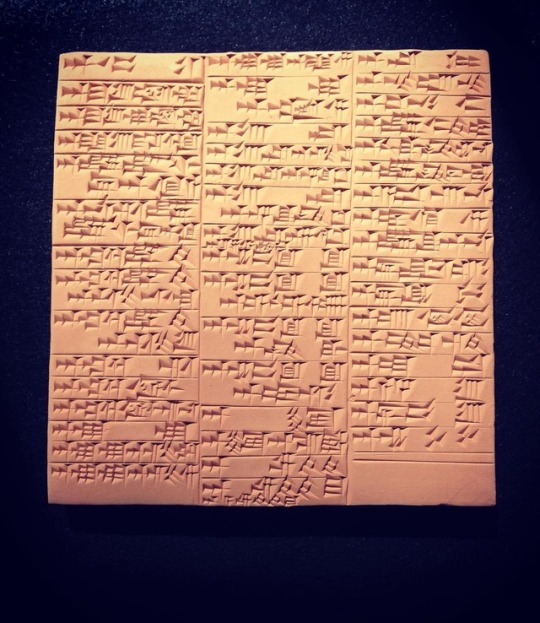
At the climax and conclusion of the famous Akkadian epic poem Enuma Elish, the chief Babylonian god Marduk defeats the primeval sea monster Tiamat and creates the universe from her corpse in a manner that is reminiscent of Yahweh’s creation of the universe in the book of Genesis. He also creates the first humans from the blood of Tiamat’s ally Qinqu. From his home city of Babylon, appointed to be the center of the universe, Marduk is appointed as king over the other gods, and given fifty names. Each name is explained in detail for the divine role that it indicates at the conclusion of the sixth and the final seventh tablet of Enuma Elish. The fifty names of Marduk have found modern expression by their attribution to the Necromonicon that is featured in the books of H.P. Lovecraft, where they are understood to have magical potency. Technically, many of Marduk’s names are actually descriptive epithets derived from his main names. Many of these were originally notable independent gods, such as Asalluhi, an important god of magic, Tutu, a god of the city of Borsippa, the agricultural god Enbilulu, the sailing god Sirsir, and the purification god Gibil/Gira, who was the personification of fire. This development is not unique to Marduk: the history of the utterly complex and long-lived Mesopotamian pantheon is full of syncretism. Particularly fundamental was Marduk’s identification with the god Asalluhi, whose cultic center was the city of Ku’ara near the prominent and most ancient cultic center of Eridu, the home of Enki/Ea, god of magic and cunning and ruler of the subterranean watery realm of the Abzu (from which modern English “abyss” comes from via Greek). Asalluhi was an important god of magic: many Sumerian incantations feature a formulaic conversation between him and his father Enki that imparts to the mortal practitioner the appropriate ritual technique. #marduk #cuneiform #necromonicon #hplovecraft #ancientgods
1 note
·
View note
Text
In honor of 20 years of Harry Potter, arguably my favorite books since I could read chapter books, I have scrolled through the British Museum’s extensive collections database to find magical gems.
Ancient Magic
What better object to begin with than a magic wand! This is an amuletic wand from the Middle Kingdom, Egypt, 2050 – 1800 BCE. Like Ron’s wand, it was broken and repaired.

Amuletic wand: Museum No. EA24426 © Trustees of the British Museum
Much of ancient magic consisted of written spells and prayers to gods. This is an Old Babylonian clay tablet from 1900-1700 BCE with a spell calling on Asalluhi, god of magic, to protect against ghosts and demons.
Clay tablet: Museum No. 96704 © Trustees of the British Museum
This is a “curse tablet” from 2nd – 3rd century Roman Britain. Instead of casting an Unforgivable, Roman Britons would inscribe their complaints on lead sheets and pray to gods (in this case Mercury) to bring misfortune down on those that wronged them.
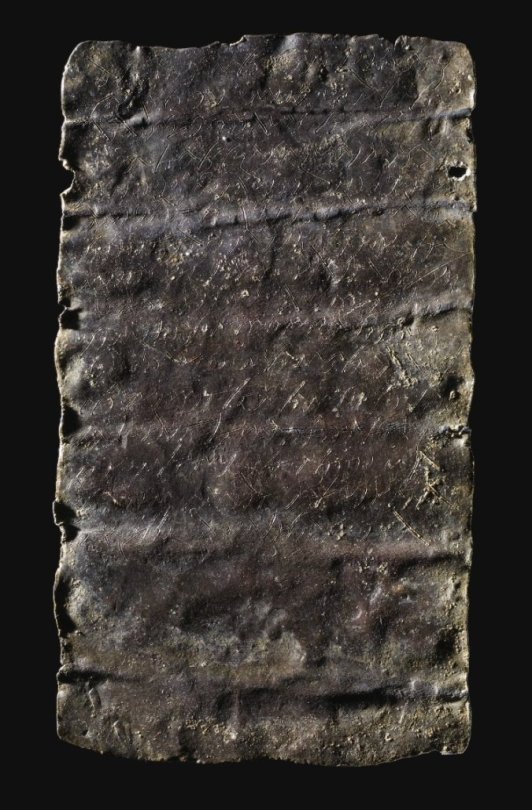
Curse tablet: 1978,0102.148 © Trustees of the British Museum
This bowl from 6th – 7th century Iraq has 13 lines of “pseudoscript” on the inside, designed to make illiterate clients think they have valid incantations. These would provide protection from demons and the like.

Incantation bowl: Museum no. 113189 © Trustees of the British Museum
Magic from around the world
This is a “ghanwah-gboreh,” a “medicine” charm made of cloth from Sierra Leone, 1908. It would mostly be used in protective white magic, changing its purpose based on which color string was used. This is a very different from Wingardium Leviosa.
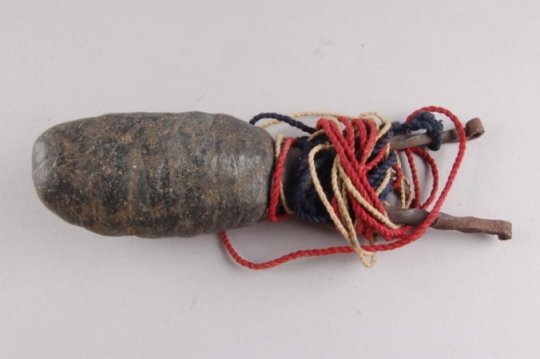
Charm: Af1908,0618.7 © Trustees of the British Museum
This magic pouch from Mare Island in Melanesia is called “waceng.” A “wacen” belongs to individual clans and holds magic stones. This one reminds me of the moleskin pouch Hagrid gave Harry to hold the things important to him.
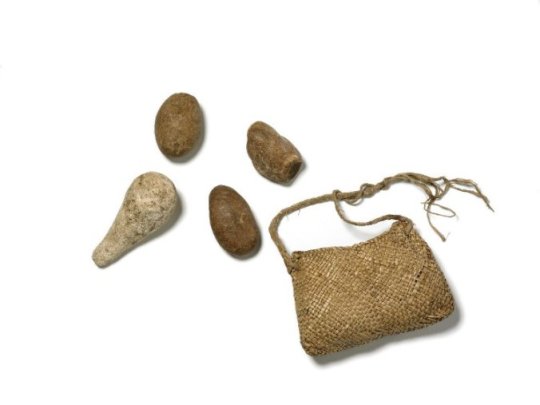
Magic pouch: Oc1854,1229.25.a © Trustees of the British Museum
This witch doctor’s blanket from Paraguay was made by “Toothle” or “Toothli” and collected in 1922, along with many other clothes and protective objects. I wish there was more about the maker, how the blanket was used, who used it. Museum collections are filled with objects still waiting to be fully researched.
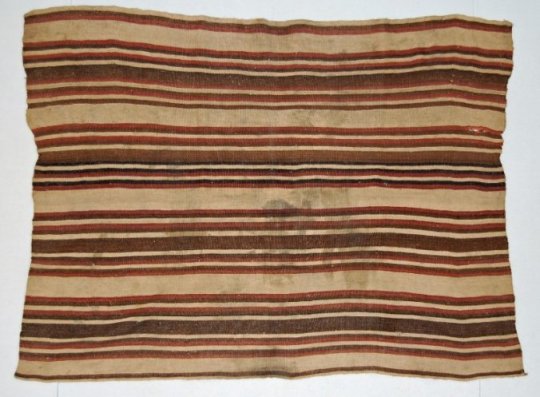
Witch doctor’s blanket: Am1922,1202.32 © Trustees of the British Museum
This one is cheating a little bit – in the world of Harry Potter, flying carpets are used in the Middle East as family vehicles. This is a gorgeous painting from an album depicting Persian costumes from about 1842.
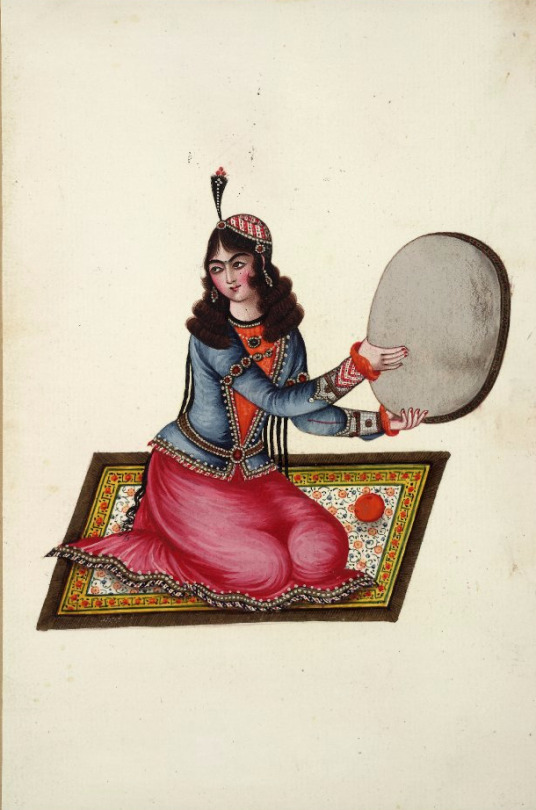
Persian costumes: 1921,0614,0.1.8 © Trustees of the British Museum
Magic takes many forms across the world, that wouldn’t be recognizable to the witches and wizards trained in Hogwarts.
A History of British Magic
Harry Potter is greatly inspired by the different expressions of magic through British history. This ring from the 13th century holds a Latin inscription – in nomine Domini – a phrase that appeared frequently in books of Christianity influenced magic. This might have been used for exorcisms.
Amulet ring: Museum No. AF.1020 © Trustees of the British Museum
These are magical wax discs used by Queen Elizabeth the First’s personal magician, Dr. John Dee. In the picture is also his obsidian shew stone, or magic mirror. He and his colleague, Edward Kelley, used these mirrors and tools to communicate with Angels. These are on display in a case about magic in the Enlightenment gallery.
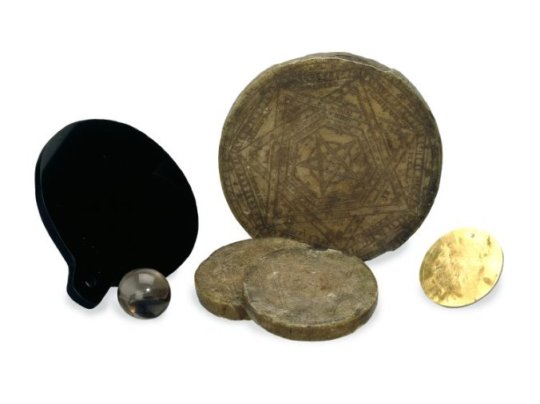
Dr John Dee’s Magical instruments: 1838,1232.90.b © Trustees of the British Museum
This 16th – 18th century numerical square/ magical disc reminds me of Hermione’s Arithmancy classes. The front are symbols of Jupiter, while the other side has a 4×4 “square of Jupiter” in Hebrew letters and the number 136. This number magic takes the sum of the numerical value of the letters, just like the Hogwarts classes.
Magical disc (back): 1885,0508.107 © Trustees of the British Museum
Magical disc (front): 1885,0508.107 © Trustees of the British Museum
Famous witches and wizards
This print shows the great wizard, Merlin, holding a wand and globe being approached by royalty. He is a mythical figure in our Arthurian stories, but in JK Rowling’s world, Merlin is a historical figure (and a Slytherin).
“Merlin” (etching on paper): 1857,1114.47 © Trustees of the British Museum
This Mercury Hebrew astrological amulet was made in the 21st century, but is based on a Renaissance talisman described by Cornelius Agrippa in 1531. He was an alchemist, like Nicholas Flamel, and wrote an influential book on the occult. Agrippa is also one of the chocolate frog cards Ron still hasn’t got.
Mercury Hebrew astrological amulet: 2011,8031.1 © Trustees of the British Museum
This print shows Shakespeare’s witches from “Macbeth” stirring a cauldron. Their potion in the play is filled with all sorts of odd ingredients that sound familiar to Snape’s potions classroom, such as “Eye of newt and toe of frog.”

Illustration to Shakespeare’s ‘Macbeth’ (act IV, scene I), the three witches around a cauldron, proof state. 1806: 1868,0822.5416 © Trustees of the British Museum
Art and Fantastic Beasts
Basilisks are throughout European folklore. Hatched from chicken eggs brooded by a toad, basilisks turn people to stone with a single look, cannot bear the sound of a rooster’s cry and cannot look at their own reflection. (So there wouldn’t be any water in the Chamber of Secrets, hint, hint).
A basilisk supporting the arms of the City of Basel (1511) Woodcut and letterpress: Museum No. E,2.373 © Trustees of the British Museum
Dumbledore’s iconic familiar is Fawkes the phoenix. This beautiful 18th century drawing is of a simurgh, a Persian phoenix, from India. There are tales of the sun bird across the globe, and always they are a symbol of hope and rebirth. RIP Dumbledore.
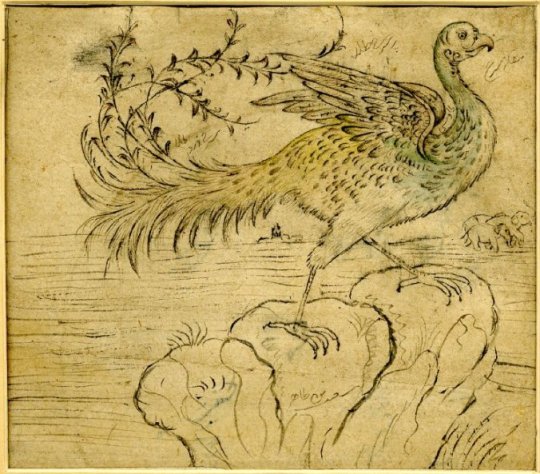
A Persian phoenix by Tachr: 1943,1009,0.6 © Trustees of the British Museum
Most of us are a little bit like Hagrid – obsessed with dragons. They have inspired countless works of art and decoration. This beautiful inro, or 5 tier case made of black and red carved lacquer, is exactly how I imagine the Chinese Fireball Krum fights in the Triwizard Tournament.
Inro (5 case), Dragon: 1974,0513.15.a © Trustees of the British Museum
Modern Magic
These bags of magic powder from Mexico City are paired with saint images for ritual use. Many places in the world still have bustling magical markets that would rival Diagon Alley. In some places, this magic is linked closely to the worship of personal saints.
Magic powder: Am1989,12.382.f © Trustees of the British Museum
This badge exemplifies the feminist heroine of the 1980s – a reimagining of a witch as a strong and free woman. This came from a growing idea that the women persecuted for witchcraft were feared for their individuality and independence. This badge reminds me of the impassioned and idealistic Hermione Granger organizing S.P.E.W. and forcing badges onto her friends.
Badge: 2005,1239.12 © Trustees of the British Museum
Art has a powerful magic all of its own.I was particularly excited to find this drawing by Osi Audu, from Nigeria. This multimedia monoprint is inspired by the artist’s Yoruba culture, and the tradition of making shrines to worship the inner head. “My aim has been to create a piece in which the shapes and the elemental charge of the objects and materials used would lend it their secret magic, or consciousness, which would be felt as the piece is seen.”
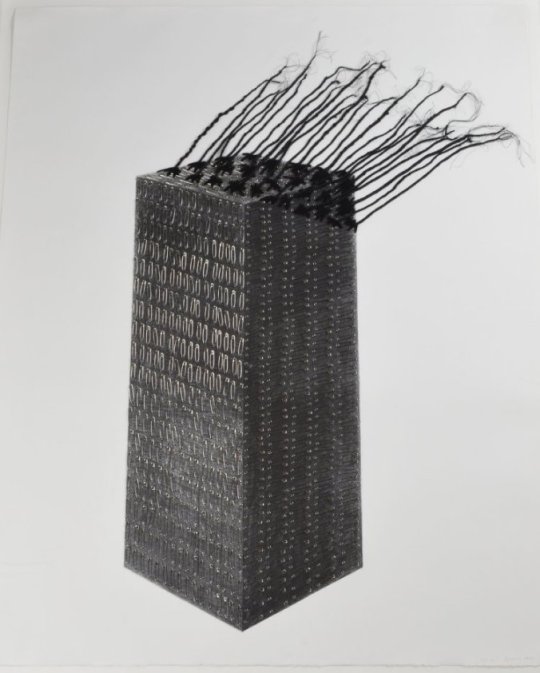
“Juju” by Osi Audu (wood, paper, metal): Af1999,14.1 © Trustees of the British Museum
Explore Further
I encourage you to go to the British Museum Collection Online and use the Advance Search function to explore further. They have all sorts of categories to investigate, and you may think of different search terms than I did, discover other hidden magical gems.
British Museum Collection Online
A History of the World in 100 Objects
The Sorcerer’s Companion: A Guide to the Magical World of Harry Potter
Pottermore
Witches in Sierra Leone (watch)
Journeys and Experiences in Argentina, Paraguay, and Chile (1920) by Henry Stephens
A Brief History of Magic at the British Library
Monsterology
Dragonology
“Shopping for Spells: Exploring Four of the World’s Witchcraft Markets” by Cynthia Pelayo, Atlas Obscura
Fantasies of Gender and the Witch in Feminist Theory and Literature by Justyna Sempruch (2008)
Akata Witch by Nnedi Okorafor
Celebrate 20 years of Harry Potter #HarryPotter20 #Witches #Wizards @BritishMuseum In honor of 20 years of Harry Potter, arguably my favorite books since I could read chapter books, I have scrolled through the British Museum’s extensive collections database to find magical gems.
#Art#British Museum#Collections Online#Ethnography#Fantasy#Harry Potter#History#JK Rowling#London#Magic
7 notes
·
View notes
Text

Day 16 & 17, Lisin and Asalluhi
These two were drawn together, though they don’t have any association besides having the same mom (Ninhursag)
Lisin:
One of several deities to have a change of gender, being reguarded initially as female and then later male (not universally, some places they were still considered female) hence I thought it would be cool to have their gender be ambiguous. Lisin’s father is Sul-pa-e (to be drawn soon!)
Their character is little known - early on they had associations with various offering goods - minerals, gazelle horns, and medicinal plants, then their male character had an affiliation with fire.
Asalluhi:
I’ve only read a few papers about him, so my info is limited. From what I understand he was the patron god of Kuara associated with divination and having many of the characteristics of his father, Enki. Then at some point he was absorbed into Marduk. I basically consider him “Diet Marduk”.
#annunaki#inktober2022#mythtober2022#ninhursag#missed opportunity to have drawn Lisin and Ashgi together#poor planning I guess
21 notes
·
View notes